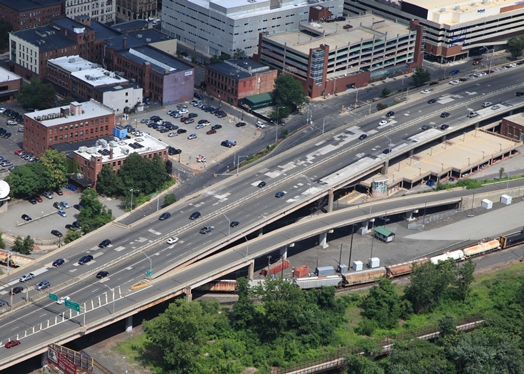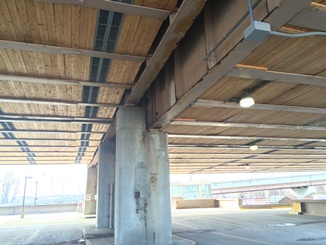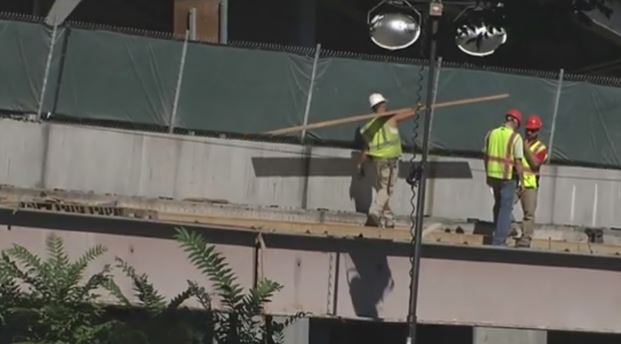By Barry Kriger
Published: September 9, 2016, 11:14 pm
SPRINGFIELD, Mass. (WWLP) – A construction worker suffered broken bones and other injuries after falling from scaffolding beneath the elevated section of I-91 in Springfield, Friday night.
Springfield Police Captain Robert Strempek told 22News the worker, a 54-year-old man from East Longmeadow, fell from 35 to 40 feet around 7:30 p.m. Friday.
“The construction foreman said he was flipping over boards on the scaffolding to get rid of debris when he slipped through a crack behind the parking garage opposite Hampden Street,” Strempek said.
The worker may have fractured his pelvis among other injuries, described as “serious.’
Captain Strempek said State Police notified the Department of Transportation and OSHA.
J.F. White Contracting Co., of Marlboro, and Schiavone Construction Co. LLC, of Secaucus, NJ are working together on the project.
=============
Springfield I-91 Viaduct Replacement
Project Highlights:
20,000 cy of Concrete
3,300 tons of Re‐Steel
310,000 Shear Studs
445 Bridge Bearing to be jacked and replaced.



The work under this MassDOT contract consists of replacing the entire existing bridge deck of the I‐91 Viaduct in Springfield, MA. The proposed improvements will allow for slightly wider left shoulders and new lighting on the structure. Also included are structural repairs to retrofit fatigue details and replace pin and hanger systems, replacement of bearings, substructure repairs and replacement of the bridge drainage system.
Additional work consists of excavation, full depth pavement construction, pavement milling and pavement overlay, pavement markings, cement concrete sidewalks and wheelchair ramps, granite curb, landscaping, and other incidental work.
By utilizing an aggressive accelerated schedule we will be able to reduce the number of traffic stages and keep construction duration to a minimum. Two travel lanes in each direction will be maintained. To facilitate flow of traffic and to minimize emergency repairs to the existing bridge deck, preemptive deck repairs and resurfacing of portions of the bridge deck will be performed.
Contract value: $148,000,150.
=========
MassDOT Invests $183.3 Million in I-91 Viaduct Project
The project covers a lot of ground from I-91 northbound and southbound, just south of State Street to the I-291 interchange ramps, and the work covers various on- and off-ramps between these limits an
📅 Tue January 26, 2016 - National Edition
Irwin Rapoport - CEG CORRESPONDENT

J.F. White-Schiavone, JV Photo Currently the J-V crews are working at night — 7 p.m. to 5 a.m. and once the demolition work begins, there will be two shifts — 7 a.m. to 3:30 p.m. and 3:30 p.m. to midnight.



The contract for the much-needed rehabilitation of the I-91 Viaduct Rehabilitation Project in Springfield, a $183.3 million Massachusetts Department of Transportation (MassDOT) initiative, was awarded to the joint-venture (J-V) of J.F. White Contracting Co. and the Schiavone Construction Co. LLC last April, and the work is progressing well.
“MassDOT is undertaking the project to replace the existing deck of the bridge, which is in poor condition,” stated the fact sheet for the project. “[It] is the result of several years of planning and valuable input from a wide variety of stakeholders. The project has been designed to reduce the number of traffic stages and keep construction duration to a minimum. Once completed, [it] will reduce annual maintenance costs, increase safety and accessibility on this busy interstate and ensure long-term serviceability.”
The project covers a lot of ground from I-91 northbound and southbound, just south of State Street to the I-291 interchange ramps, and the work covers various on- and off-ramps between these limits and the I-291 ramp structures.
“The completed bridge cross-section will be similar to the existing bridge width, with a wider left shoulder, three travel lanes and a wider right shoulder,” stated the fact sheet. “During construction, there will be one travel lane north of the I-291 ramps, while two lanes will be maintained on the viaduct in each direction, with occasional exceptions possible. In addition to the bridge and highway improvements within the limits of the viaduct, MassDOT is proposing bridge drainage system enhancements that will improve water quality in the Connecticut River. Other improvements will include new lighting on the viaduct, the upper levels of the north and south garage, and the Columbus Avenue railroad underpass.”
The J-V submitted the lowest price for the project (of which three bids were submitted) — $148 million making JF White-Schiavone the low bidder for the project. When the costs of railroad flaggers, traffic details, protections against cost overruns and an incentive clause for the contractor to expedite the work are included, the project will cost approximately $183.3 million. Federal Highway funding is covering 80 percent of the cost, with state covering the remainder.
The contract terms include an incentive of $50,000 per-day for each day that the contractor completes the work early — a maximum of 180 days. There also is “a disincentive clause” that penalizes the contractor $50,000 for each day the work continues past the expected point where drivers should be expected to have full, beneficial use of the corridor.
“The approval allows for the replacement and rehabilitation of the concrete deck; repair and replacement of the supporting steel; and major improvements to drainage and lighting,” stated a press release for the awarding of the contract. “The existing viaduct was built in the late 1960s and generally consists of a concrete deck slab supported on steel girders. The girders are supported by steel pier caps, column piers and footings with pile foundations. Several rehabilitation projects were performed on the structures over the past 25 years. The viaduct has experienced significant deterioration and requires frequent emergency repairs, which exacerbates traffic congestion. In recent inspections, MassDOT found that the bridge deck needs replacing. While a long-term solution will be determined through a corridor planning study currently under development, this contract guarantees lower maintenance costs and a reduction in the need for emergency repairs for the next 30 years.”
Thomas J. Tinlin, MassDOT highway administrator re-iterated the need for the work.
“For too long, the viaduct has required frequent — and untimely—emergency repairs,” he said. “Recognizing the impact those repairs have on the regional economy and on mobility through the corridor, the contractor's methods and our contractual incentive shows that we understand the urgency with which this needs to get done.”
The work began in July and should be completed in February 2019. MassDOT has authorized the use of accelerated bridge construction techniques to “reduce the number of traffic impacts and minimize disruptions to traffic flow caused by construction.”
The first phase includes utility work, intersection improvements and bridge deck repairs with nightly lane restrictions and early on MassDOT is taking the lead on trying to speed up construction. Sunday through Thursday nights through fall 2015, lanes on I-91 north and/or southbound will be closed to allow the contractor to mill out the existing pavement and repair the concrete deck.
For the duration of the work, two travel lanes will be maintained in both directions; the on- and off-ramps within the project limits will be closed for the length of the project. Traffic seeking to access downtown streets will be diverted off I-91 before and after the project limits.
The elevated viaduct carries I-91 through Springfield — approximately 75,000 vehicles per-day, with the I-291 interchange to the north and State Street to the south — with 90,000 vehicles per-day. Moreover, the viaduct “is the primary north-south route between Connecticut, Massachusetts and Vermont, and it experiences extensive vacation traffic during the weekends in the summer and winter.”
MassDOT is taking traffic management seriously for the multi-year project, with regional traffic to be maintained on the existing bridge and local traffic on the surrounding city streets.
“Traffic will be managed during the deck replacement through a combination of lane closures and shifts,” stated the fact sheet, “to establish work zones on the interior and then exterior of the northbound and southbound viaduct to complete the work.”
Various ramp closures are being planned for I-91 and I-291 and new speed limits are being implemented to help protect the construction crews.
“The new speed limits are enforced by the Massachusetts State Police for the project duration,” stated the fact sheet. “A speeding ticket within the work zone comes with a double fine. Public safety is paramount and these restrictions will protect motorists and those working in the construction zone on I-91.”
MassDot also engaged in a major public-information campaign to ensure that commuters and businesses are fully aware of the scope of the project and the safety measures that are being implemented.
Bob Murphy, the joint venture's project executive and a vice president with J.F. White, noted that there is only one construction season.
“It's all year-round,” he said. “We work through the winter — there is no shutdown. We work through the winter all the time. Last winter we had record snowstorms and we had only one day when my crews didn't show up. We were driving piles and working over the water, and they showed up. We have break trailers that are heated and everything we need to ensure that the crews can stay warm and work safely. When you are working in winter conditions, you have to dress for it.”
The crews are in the beginning phase — the pre-emptive repairs phase.
“Before we can switch traffic permanently to a two-lane configuration behind barriers while we do the construction,” said Murphy, “they want us to do pre-emptive repairs on the deck to prevent potholes from forming. When you get a pothole formed when you are in this situation, it's going to be a massive problem. MassDOT is trying to make sure that the deck is repaired enough to take the traffic through the 1.5 years that we need the deck to last.”
Starting in December, J-V crews will start taking the deck off the southbound lanes — 48 individual spans, a process that will take three to four months.
“We'll be starting the deck form work in February depending on how bad the winter gets,” said Murphy. “When the form work is done, we can put in the rebar.”
When the 4,800-ft.-(1,463 m) long bridge project is delivered, J-V crews will have removed 30,000 tons (27,216 t) of concrete, 3,500 tons (3,175 t) of rebar and 1,200 tons (1,089 t) of asphalt. In terms of new materials, 15,000 cu. yds. (11,468 cu m) of concrete, 3.5 million lbs. (1.6 million kg) of rebar, and 200,000 lbs. (90,718 kg) of structural steel will be brought in.
Bringing in construction materials also will be a challenge.
“Logistics are going to be extreme and a nightmare,” said Murphy. “We're going to be doing a lot of traffic merging and taking lanes at times. We're going to be doing deliveries at night to minimize some of the traffic impacts, but we've been working with our concrete, rebar and other suppliers and we've got a good plan scoped out.”
Currently the J-V has 90 people on site, including subcontractors, and this number will increase to more than 200 in the spring. Among the main subcontractors are those responsible for the painting and the steel erection and repairs.
The new deck will not be widened or lengthened. Below the deck are mainline tracks operated by CSX Transportation, Pan Am Railways, Inc. and Amtrack, an area known as the Diamond Interchange, which has tracks going in all four directions.
Murphy's crews will be installing a 100-percent containment shield within the next three weeks. The hours for this erection will be determined by the railways, which have collaborated to appoint one person to be their point of contact with contractor and MassDOT.
“Once we get the containment shielding up and everything is protected,” said Murphy, “we can work whenever we want. We'll be working with the railway flagmen until the system is erected. They set up a good package with this one point of contact. We understand the coordination and we're not scared by it. We may get a call saying ‘you have 1.5 hours to get out there and do some work' and we're ready to jump on that opportunity.
“Whatever we need to do or whenever difficult conditions come up,” he added, “our railway contact will take care of things and he'll also let us know what's going on so that we can resolve any issues. I've done several projects where we replaced rail bridges and worked below and above them. The company has a lot of experience with working on and around railway infrastructure. We've always had a good rapport with railways. After one of our latest jobs, Amtrak knew how tough it was to get work done and they did a great job in helping us out.”
Communications between MassDOT and the J-V are solid.
“This is a very high profile job and it's getting a lot of attention,” said Murphy, “and a lot of people are all behind us in getting it done as fast as we can.”
Murphy appreciates the traffic measures that MassDOT has brought in to protect the construction workers and public.
“They legally lowered the speed limit and it's a big procedure to get a legal one done,” he said. “When you have a speed limit posted on orange signs, those are just recommended and not enforceable. But they made this area enforceable — 40 mph and a couple of nights ago, the police pulled over a couple of tractor-trailers in the work zone that were doing 75 mph.
“Those high speeds will blow the hammer out of your hands,” he added. “We're behind drums right now. When we get the repairs done to the deck, we'll be behind concrete barriers. We take safety seriously and the state has helped out with police patrols to control traffic. The message is getting out and we appreciate that.”
Ralph Romano, resident engineer for the MassDOT Highway Division, has a staff of seven engineers and inspectors.
“So far, we've had no major issues to deal with,” he said. “We work very hard at communication — weekly meetings with the contractors and designers, as well as weekly briefings with the area DPW people and other interested stakeholders. To date, the White-Schiavone team has shown a commitment to safety, and their product has been excellent.”
Currently the J-V crews are working at night — 7 p.m. to 5 a.m. and once the demolition work begins, there will be two shifts — 7 a.m. to 3:30 p.m. and 3:30 p.m. to midnight.
“We're working at night because right now we can only take lanes at 8 or 9 p.m. to push people over,” said Murphy, “so a second shift in the morning doesn't work out.”
J.F. White is providing the majority of the workers and equipment. Schiavone Construction is focusing its efforts on management and supervision, steel repairs and deck reconstruction.
Equipment-wise, the J.V. is employing Cat and Volvo excavators, loaders and backhoes for the roadwork and intersection improvements. For the demolition, which will be done by hand, a variety of jackhammers will be used, along with Bobcats and small dump trucks for the cleanup.
Onsite mechanics will be brought in later as the work escalates. J.F. White's closest equipment yard and shop is two hours away in Stoughton, Mass. Mechanical help is provided by mechanics sent to the site and by dealerships in the Springfield area.
The J-V has plenty of space underneath the bridge for temporary offices, materials storage and the parking of equipment. All vehicles are parked under the bridge at night. When the concrete barriers are established, equipment will be left on site
J.F. White takes equipment maintenance seriously, from daily inspections and reports filled out by the operators to the mechanics and equipment staff, who ensure that routine and scheduled maintenance are done
“We take pride in our fleet — totally and extremely,” said Murphy. “We do inspections all the time and we make sure that our mechanics have the training they need and access to the latest reports from the manufacturers.”
Murphy, who has been in construction for 38 years, has some bridge work experience, but not on this scale.
“I cut my teeth on deck removal and replacement,” he said, “but we're doing this 96 times in the middle of a city and twice as fast. This is a four to five year job and we're going to try to do it in a little over two to three years.”
Assisting Murphy are Chris Pehl, the project's superintendent and Tim Goodridge, project engineer.
“I am looking forward to performing this large-scale bridge reconstruction project which will require high production rates,” said Pehl. “Achieving high production rates while providing a quality project is always rewarding. Every new project, large and small, provides new learning experiences, which is the most interesting part of construction. After 23 years in the business, I am still learning new techniques and methods.”





